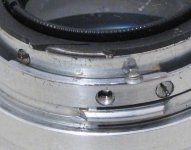Grytpype
Well-known
I've just started the dismantling of a collapsible f2 Sonnar. Three questions (maybe more later!):
This lens did not "snap into position" as people describe. It wouldn't go fully into position at all. Now I have looked at it I find there are 2 countersunk screws; one is the stop and the other (shown removed in the picture below) is what should presumably be the latching-screw. This is an extremely short screw with a rather mutilated end, which has in turn mutilated the end of the wedge on the locking ring and it would not pass the screw. What should this screw look like, and how does it work with the locking-ring?
If I remove the little countersunk screw at the back of the outer lens-barrel (visible at the left of the picture), should the locking-ring unscrew, allowing me to remove the mounting sleeve, or should I remove the rear element first? I have tried it and the locking-ring is extremely tight, and I don't want to force it.
Am I right in thinking that the basic construction of the lens is the same as the Jupiter-8?
Thanks, Steve.
This lens did not "snap into position" as people describe. It wouldn't go fully into position at all. Now I have looked at it I find there are 2 countersunk screws; one is the stop and the other (shown removed in the picture below) is what should presumably be the latching-screw. This is an extremely short screw with a rather mutilated end, which has in turn mutilated the end of the wedge on the locking ring and it would not pass the screw. What should this screw look like, and how does it work with the locking-ring?
If I remove the little countersunk screw at the back of the outer lens-barrel (visible at the left of the picture), should the locking-ring unscrew, allowing me to remove the mounting sleeve, or should I remove the rear element first? I have tried it and the locking-ring is extremely tight, and I don't want to force it.
Am I right in thinking that the basic construction of the lens is the same as the Jupiter-8?
Thanks, Steve.


